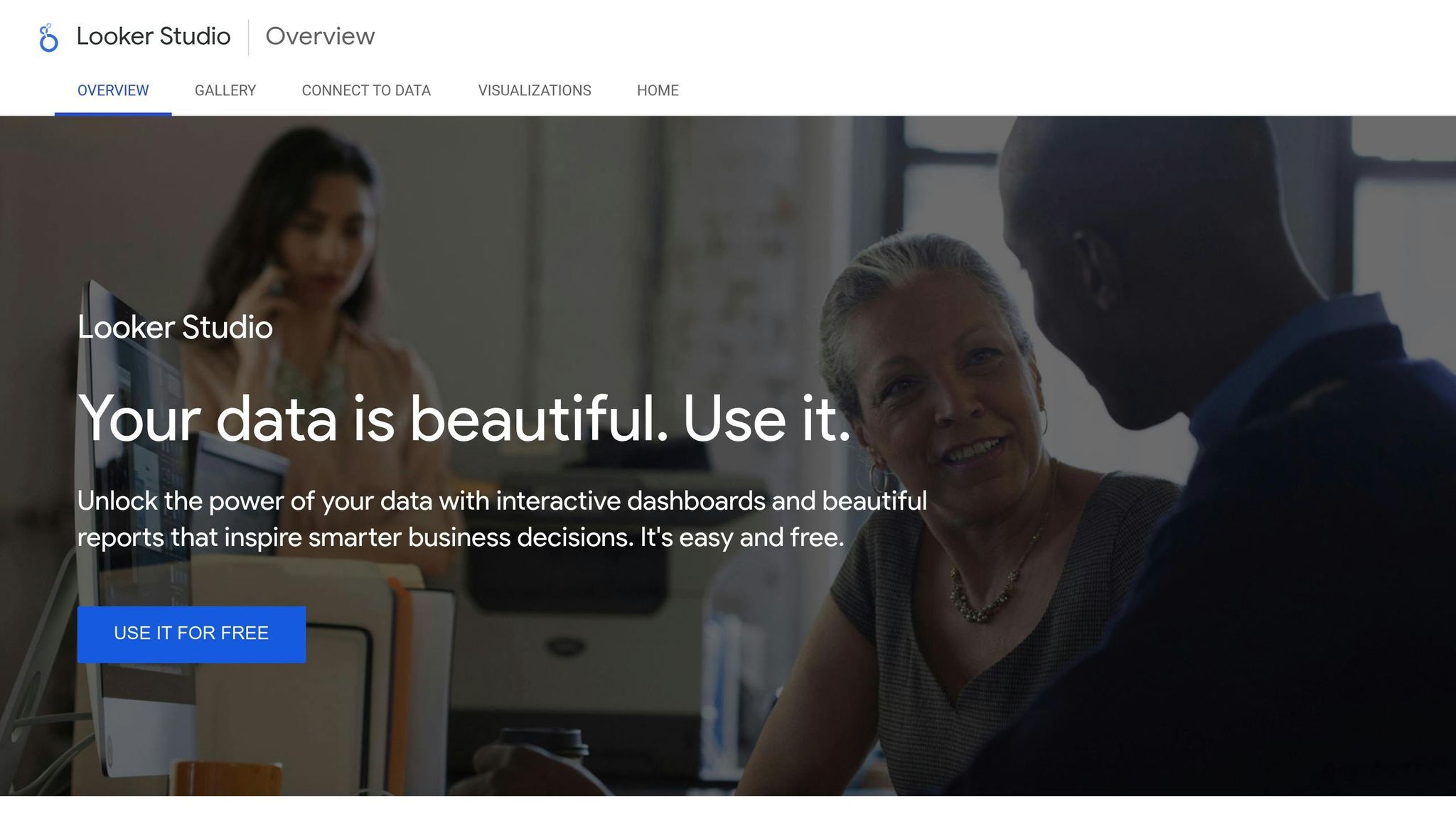Want to measure the real impact of your content? A Content ROI Dashboard simplifies your data, showing you exactly how your marketing efforts are performing. Whether it's tracking revenue, optimizing budgets, or improving customer acquisition, this tool is your key to smarter decisions.
Key Benefits of a Content ROI Dashboard:
- Track Revenue Impact: See how much revenue each piece of content generates.
- Optimize Spending: Identify the most cost-effective channels and campaigns.
- Real-Time Insights: Monitor performance metrics like CAC, ROAS, and engagement rates.
- Simplify Data: Combine fragmented sources into one clear, actionable view.
Core Metrics to Track:
- Financial: Revenue attribution, CAC, ROAS.
- Performance: Conversion rates, engagement scores.
- Efficiency: LTV/CAC ratio, cost per lead.
Quick Steps to Build One:
- Set Goals: Define KPIs tied to your business outcomes.
- Connect Data: Integrate platforms like analytics, CRM, and ad tools.
- Choose a Tool: Use Google Looker Studio or Power BI for visualization.
- Automate Updates: Ensure metrics refresh in real time.
This dashboard isn't just a tool - it's your roadmap to data-driven marketing success.
Key ROI Metrics to Track
Money Metrics
Financial metrics help you understand the revenue impact of your content:
- Revenue Attribution: Measure how much revenue each piece of content and channel generates.
- Customer Acquisition Cost (CAC): Keep tabs on the total cost of acquiring a new customer.
- Lead Generation Cost: Calculate the expense involved in generating qualified leads.
- Return on Ad Spend (ROAS): Determine the revenue earned for every dollar spent on advertising.
A well-organized dashboard can tie these metrics to specific campaigns and content types, making it easier to spot high performers and identify areas that need improvement.
Performance Metrics
These metrics help evaluate how effectively your content engages and converts your audience:
- Conversion Rate: Percentage of visitors who take a desired action.
- Time on Page: Average time users spend consuming your content.
- Bounce Rate: Percentage of visitors leaving after viewing just one page.
- Click-Through Rate (CTR): Ratio of clicks to impressions.
- Content Engagement Score: A combined measure of shares, comments, and other interactions.
| Metric Type | What to Track | Why It Matters |
|---|---|---|
| Traffic | Unique visitors, page views | Measures how far your content reaches |
| Engagement | Time on page, scroll depth | Reflects how engaging your content is |
| Conversion | Form fills, downloads | Tracks completed actions |
Cost-Effectiveness Metrics
These ratios evaluate how efficiently you're spending your marketing budget:
- LTV/CAC Ratio: Compare customer lifetime value to acquisition cost.
- Cost Per Lead (CPL): Divide total spending by the number of leads generated.
- Cost Per Acquisition (CPA): Calculate the marketing cost per converted customer.
- Marketing ROI: Use the formula (Revenue - Marketing Cost) / Marketing Cost to measure return.
These metrics highlight the most profitable channels and guide resource allocation for better results.
"Experiment Driven's AI-powered insights and real-time dashboards provided clarity on our performance, enabling smarter, data-driven decisions."
Keep these metrics updated in real time across all marketing channels. This approach eliminates blind spots and allows for swift adjustments based on performance trends.
Once you've outlined these key metrics, the next step is creating a dashboard that consolidates these insights for real-time analysis.
How to present marketing ROI with Google Looker Studio

Building Your ROI Dashboard
Creating a content ROI dashboard requires thoughtful planning. Here's how to build one that provides actionable insights.
Set Goals and Requirements
Start by identifying metrics that align with your business goals. Focus on the key performance indicators (KPIs) that directly influence your content marketing outcomes. Your dashboard should address questions like:
- Which content channels generate the most revenue?
- What’s the ROI of different content formats?
- How well are we converting visitors into customers?
Connect Data Sources
Integrate your data platforms to get a full picture of content performance. Here’s an example of essential data sources and metrics:
| Data Source Type | Key Metrics to Pull | Update Frequency |
|---|---|---|
| Analytics Platform | Traffic, engagement | Real-time |
| CRM System | Lead quality, conversion | Daily |
| Ad Platforms | Campaign performance | Hourly |
| Sales Data | Revenue attribution | Daily |
Pick a Dashboard Tool
Choose a tool that fits your technical needs and team’s expertise. Popular options include Google Looker Studio and Power BI, known for their strong data visualization capabilities. Look for features like integration options, customization, real-time updates, user permissions, and overall cost.
Create Clear Data Layouts
Organize your dashboard to make the most important metrics easy to spot. For example, a large SaaS company improved executive reporting by structuring their dashboard into sections:
- Top: Revenue metrics
- Middle: Performance indicators
- Bottom: Cost-efficiency ratios
Set Up Auto-Updates
Automate data refreshes to ensure teams are working with the latest information. Follow these best practices for auto-updates:
- Schedule refresh intervals based on how often data sources update
- Set alerts for major metric changes
- Perform regular data quality checks
- Maintain backup connections for reliability
- Use direct data connections for real-time accuracy
Once your dashboard is set up and auto-updates are in place, test and tweak it to ensure it meets your needs effectively.
sbb-itb-d4df0e6
Dashboard Testing and Adjustments
Test your dashboard to ensure it delivers accurate and useful insights. Once you’ve connected your data and set up a clear layout, thorough testing helps fine-tune its performance.
Track Individual Channels
Track each channel separately to pinpoint which content and distribution strategies yield the best returns. Here's how:
- Link Data Sources: Combine your data into a single view that aligns with your business goals, reducing gaps in performance tracking.
- Monitor Channel-Specific KPIs: Focus on metrics unique to each channel. For instance, channel-specific tracking helped one company boost revenue by 35%.
Here’s a breakdown of key metrics for different channels:
| Channel Type | Primary KPIs | Secondary KPIs |
|---|---|---|
| Blog Content | Conversion Rate, Time on Page | Bounce Rate, Social Shares |
| Social Media | Engagement Rate, Click-through Rate | Reach, Brand Mentions |
| Email Marketing | Open Rate, Revenue per Email | List Growth, Unsubscribe Rate |
| Paid Content | ROAS, Cost per Conversion | Impression Share, Quality Score |
Use these insights to refine your strategy and focus on what works best.
Test and Measure Results
Once you’ve set up tracking, test your dashboard to make sure it’s accurate and actionable. For instance, a pet tech brand reduced acquisition costs by 46% in just three months through systematic testing.
Steps for Data Validation:
- Cross-check metrics across platforms.
- Compare current data with historical trends.
- Look for unusual data patterns or errors.
- Confirm accurate attribution for all channels.
Experimentation Framework: Keep your testing organized by documenting:
- Your hypothesis and testing parameters.
- Results from the control group versus variations.
- Statistical significance of outcomes.
- The impact on revenue or other key metrics.
Real-Time Monitoring: Set up automated alerts for major changes in metrics. Regularly verify data consistency and check for tracking issues or performance fluctuations. This helps you react quickly to any unexpected shifts.
Dashboard Management Tips
After you've tested and fine-tuned your dashboard, proper management is key to keeping insights flowing smoothly.
Keep Metrics Simple
The best ROI dashboards focus on keeping things clear and easy to understand. Group related metrics together, stick to consistent color schemes, use clear labels, and include trend lines to make raw data easier to interpret.
Here’s a simple way to organize key metrics:
| Metric Category | Primary View | Supporting Data |
|---|---|---|
| Revenue Impact | Monthly trend graph | Daily breakdown |
| Content Performance | Conversion rate chart | Traffic sources |
| Cost Analysis | ROI by channel | Expense breakdown |
Maintain Current Data
Keeping your data accurate and up-to-date is non-negotiable. Regular checks can help you catch errors or inconsistencies before they cause problems.
Here are some tips for maintaining data accuracy:
- Schedule Regular Audits: Perform weekly audits to ensure integrations are working and data is being tracked correctly.
- Monitor Data Sources: Set up alerts to catch tracking failures or unusual patterns early.
- Update Dashboard Components: Review and refresh dashboard elements every quarter to ensure they align with your current goals.
When your data is reliable, you can confidently use it to make informed marketing decisions.
Act on Dashboard Data
Once your data is up-to-date and accurate, it’s time to put those insights to work.
"Experiment Driven is like a SWAT team for marketing. They come in to tackle our biggest challenges, such as wasted ad spend and misaligned teams. They run fast, data-driven experiments to find out what works best for our audience and help us optimize our strategies. Their team seamlessly integrates with ours, ensuring everyone is aligned and focused on our growth goals. With their AI-powered insights and real-time dashboards, we gained clarity on our performance and made smarter decisions. Overall, they transformed our marketing efforts into a well-oiled machine that drives sustainable growth."
– Experiment Driven Customer
Here’s how you can use dashboard data to guide your strategy:
- Channel Performance: Focus on channels delivering the best ROI and scale efforts there.
- Content Strategy: Use engagement data to shape your content creation and distribution plans.
- Budget Allocation: Reallocate resources to areas that consistently perform well based on real-time data.
- Team Alignment: Share insights with marketing, sales, and product teams to ensure everyone is working toward the same goals.
Conclusion: Making Data-Driven Decisions
Setting up a content ROI dashboard is just the beginning; its real purpose is to guide smart decision-making. Companies that base their strategies on data often see better results in fine-tuning their marketing efforts and reaching their goals.
A well-kept dashboard turns raw numbers into insights you can act on, shaping your marketing approach. By monitoring key metrics, teams can make decisions that directly drive growth.
Your dashboard should act as a central hub, helping you:
- Spot underperforming channels fast
- Shift budgets to initiatives that deliver results
- Measure the impact of marketing experiments
- Keep teams focused on shared growth targets
Think of your content ROI dashboard as a tool that grows with your business. When you make it part of your daily routine, it becomes essential for marketing leadership. Regular updates and acting on its insights allow for smarter decisions and steady growth.
This dashboard helps keep your business on track toward its goals.
